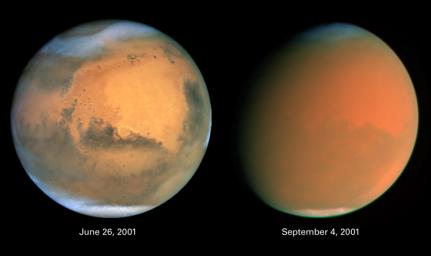Scientists Track “Perfect Storm” on Mars
Caption:
Two dramatically different faces of our Red Planet neighbor appear in these comparison images showing how a global dust storm engulfed Mars with the onset of Martian spring in the Southern Hemisphere. When NASA’s Hubble Space Telescope imaged Mars in June, the seeds of the storm were caught brewing in the giant Hellas Basin (oval at 4 o’clock position on disk) and in another storm at the northern polar cap.
When Hubble photographed Mars in early September, the storm had already been raging across the planet for nearly two months obscuring all surface features. The fine airborne dust blocks a significant amount of sunlight from reaching the Martian surface. Because the airborne dust is absorbing this sunlight, it heats the upper atmosphere. Seasonal global Mars dust storms have been observed from telescopes for over a century, but this is the biggest storm ever seen in the past several decades.
Mars looks gibbous in the right photograph because it is 26 million miles farther from Earth than in the left photo (though the pictures have been scaled to the same angular size), and our viewing angle has changed. The left picture was taken when Mars was near its closest approach to Earth for 2001 (an event called opposition); at that point the disk of Mars was fully illuminated as seen from Earth because Mars was exactly opposite the Sun.
Both images are in natural color, taken with Hubble's Wide Field Planetary Camera 2.
Cataloging Keywords:
| Name |
Value |
Additional Values |
| Target |
Mars |
|
| System |
|
|
| Target Type |
Planet |
|
| Mission |
Hubble Space Telescope (HST) |
|
| Instrument Host |
Hubble Space Telescope |
|
| Host Type |
Space Telescope |
|
| Instrument |
Wide Field/Planetary Camera 2 (WFPC2) |
|
| Detector |
|
|
| Extra Keywords |
Atmosphere, Color, Dust, Infrared, Storm, Visual |
| Acquisition Date |
|
| Release Date |
2001-10-13 |
| Date in Caption |
|
|
| Image Credit |
NASA, James Bell (Cornell Univ.), Michael Wolff (Space Science Inst.), and the Hubble Heritage Team (STScI/AURA) |
| Source |
photojournal.jpl.nasa.gov/catalog/PIA03173 |
| Identifier |
PIA03173 |

 Planetary Data System
Planetary Data System
